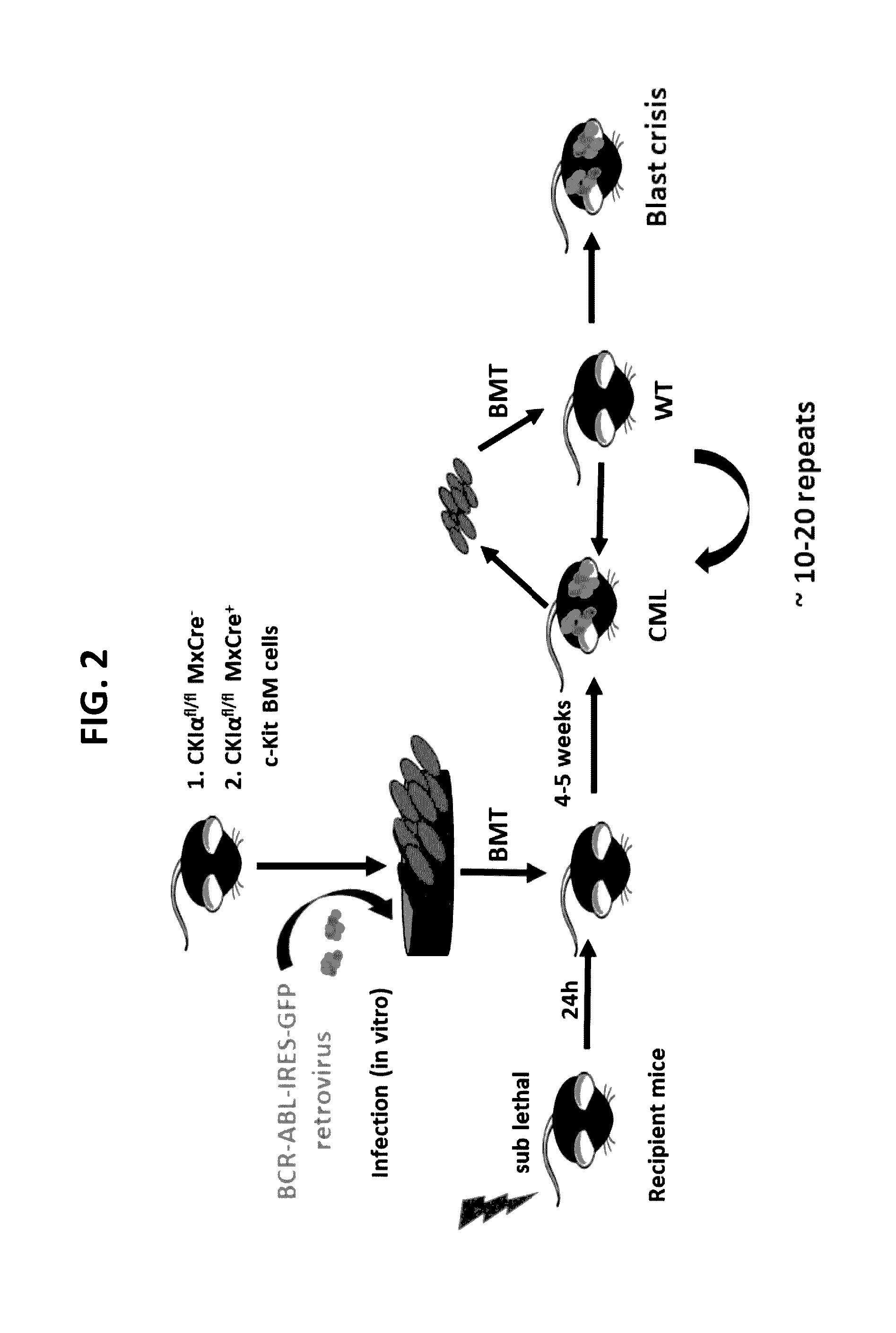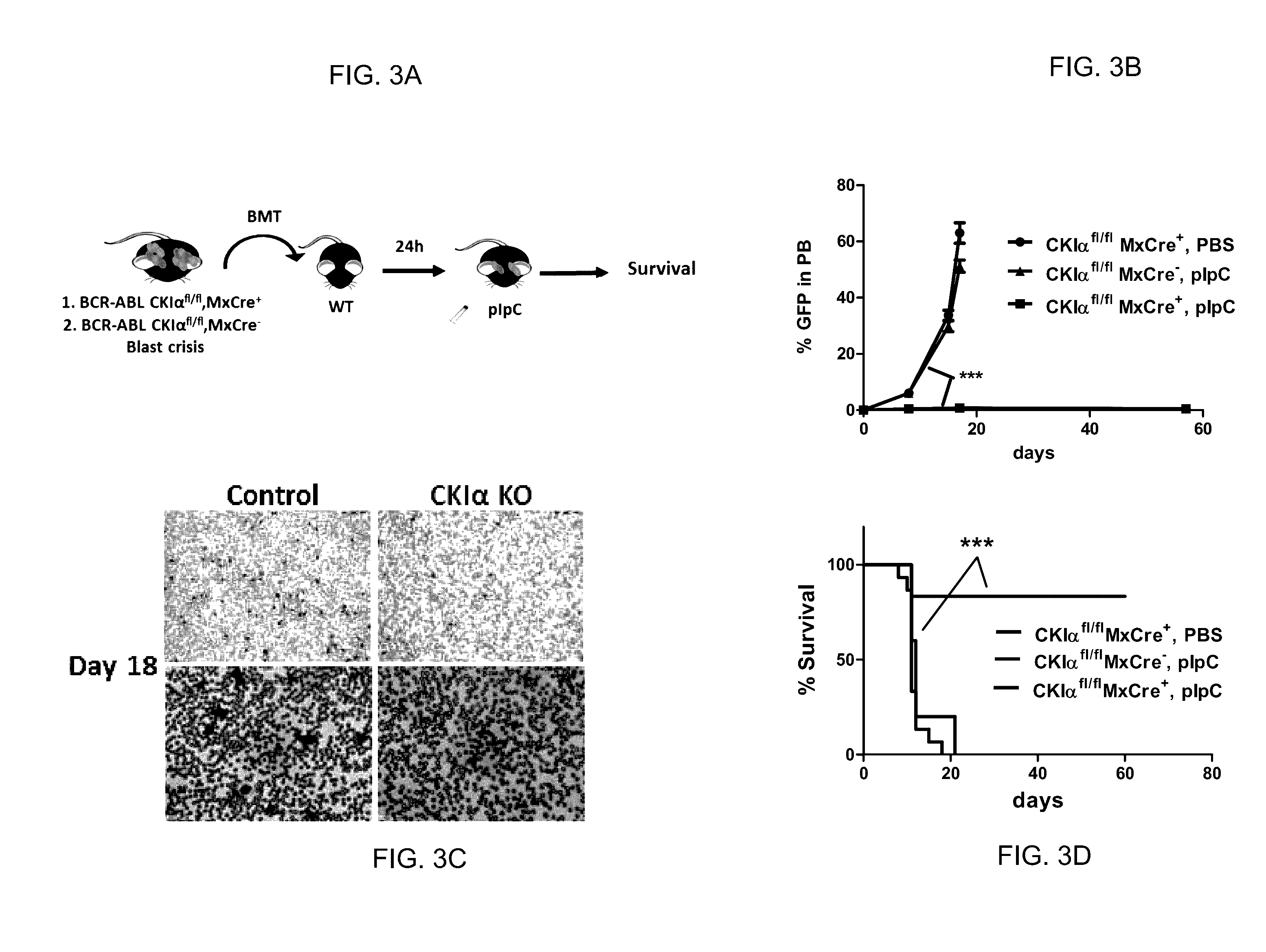Use of casein kinase i inhibitors for depleting stem cells
a technology of kinase i inhibitors and stem cells, which is applied in the direction of biochemistry apparatus and processes, instruments, drug compositions, etc., can solve the problem of aberrant accumulation of nuclear -catenin
- Summary
- Abstract
- Description
- Claims
- Application Information
AI Technical Summary
Benefits of technology
Problems solved by technology
Method used
Image
Examples
example 1
CKIα Deletion Leads to Normal HSC Depletion Allowing Bone Marrow Reconstitution
[0272]Cklα lfl / fl Mx-Cre transgenic mice were generated in order to analyze the effect of CKIα deletion in bone marrow. Mx-Cre is induced not only in the BM but also in the liver and spleen. To ensure that the phenotype observed is specific to CKIα deletion in the BM and not in other tissues, the bone marrow of Cklα lfl / fl Mx-Cre transgenic with GFP mouse was injected into a lethally IR WT mouse. By doing that, it was ensured that upon pIpC injection to the recipient mouse CKIα deletion is effected only in the BM and not in other tissues. Long term (LT) engraftment was validated by determining stable donor GFP positive cells in the peripheral blood 2 months following the transplantation. Only upon validation of successful engraftment, was pIpC injected.
[0273]Upon CKIα KO induction (with pIpC) the mice develop a lethal pancytopenia due to reduced HSC numbers resulting in a 20 days median survival (FIG. 1C)...
example 2
CKIα Deleted Bone Marrow Prevents Bcr-Abl Driven Leukemia Genesis
[0274]Bone marrow from mice carrying foxed alleles of CKIα with Mx-Cre or without were infected with a Bcr-Abl carrying retrovirus and injected into sub-lethally irradiated WT recipient mouse (FIG. 2). Next, the BM from the sick mouse was taken and engrafted into a WT mouse. This procedure was repeated multiple times until the chronic leukemia disease turned into an aggressive acute blast crisis disease, with multiple blast cell in the BM and peripheral blood and death within 2-3 weeks.
[0275]While in the first generation, the mice died after approximately 5 weeks, in the next generation the mice survived only two weeks after the transplantation because they suffer from a more aggressive disease. Furthermore, there was no further need to irradiate the leukemia recipient mouse after a few repeated transplantation, attesting to the aggressive nature of the leukemia.
[0276]To test the effect of CKIα ablation on CML developm...
example 3
Effect of the CKI Inhibitor PF670462 on Leukemia Cells
[0283]Next, the present inventors evaluated the effect of PF670462, a CKI inhibitor on normal BM and leukemia cell in vitro. PF670462 is considered CKI-delta / epsilon specific inhibitor (Long A, Zhao H, Huang X. J Med Chem. 2012 Jan. 26; 55(2):956-60. doi: 10.1021 / jm2013875) and therefore is not supposed to activate the Wnt or p53 pathway (Price M A, Genes Dev. February 15; 20(4):399-410). When the cells were treated with the inhibitor in vitro, an upregulation of Wnt and p53 in a dose dependent manner was observed in bone marrow cell analysis (FIG. 5B), indicating CKIα inhibitory activity (Elyada et al, Nature. 2011 Feb. 17; 470(7334):409-13. doi: 10.1038 / nature09673). Remarkably, a significant difference between the cell type after treatment with the inhibitor was observed, while the normal BM cell number was only slightly reduced upon treatment with increasing concentration of the inhibitor, the decline in the leukemic cell num...
PUM
| Property | Measurement | Unit |
|---|---|---|
| time | aaaaa | aaaaa |
| time | aaaaa | aaaaa |
| β-catenin | aaaaa | aaaaa |
Abstract
Description
Claims
Application Information
 Login to View More
Login to View More - R&D
- Intellectual Property
- Life Sciences
- Materials
- Tech Scout
- Unparalleled Data Quality
- Higher Quality Content
- 60% Fewer Hallucinations
Browse by: Latest US Patents, China's latest patents, Technical Efficacy Thesaurus, Application Domain, Technology Topic, Popular Technical Reports.
© 2025 PatSnap. All rights reserved.Legal|Privacy policy|Modern Slavery Act Transparency Statement|Sitemap|About US| Contact US: help@patsnap.com



